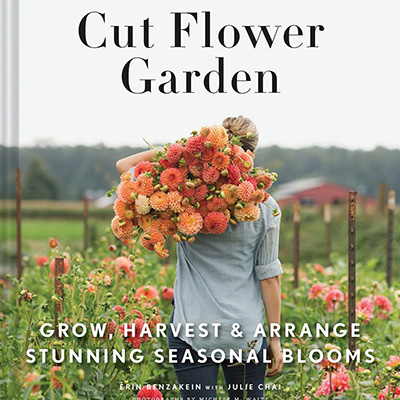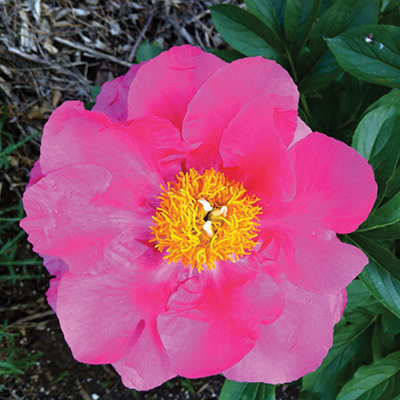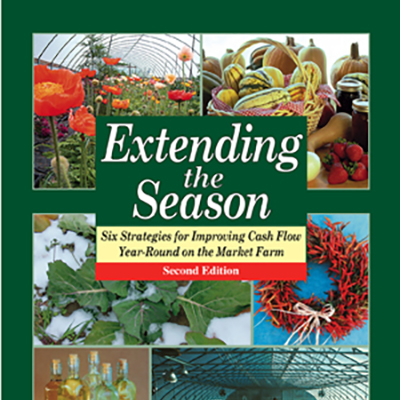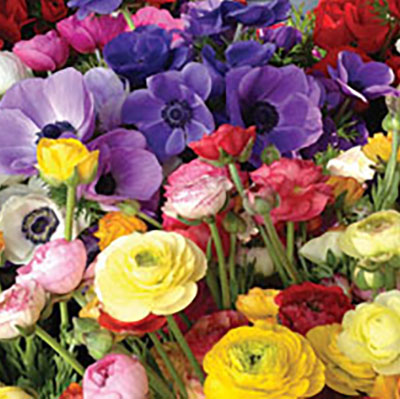I hope everyone enjoyed 2014. It was a great year for us—productive and profitable! After analyzing our sales, we have come up with a list of our top-selling crops for grocery stores and for florists.
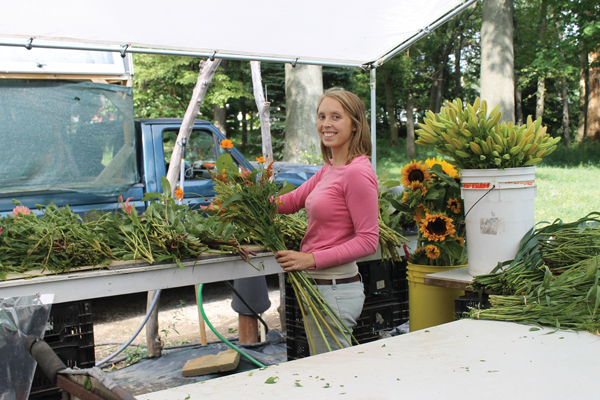
Gretel Adams makes some of the 10,000 bouquets she sold last year.
We started selling to a grocery distribution center, which shifted our focus a bit here at the farm. We were trying to expand our florist sales because that’s where we get our highest price wholesale, but realized that in our market, we were maxed out unless we wanted to drive to the next nearest city. When we thought about driving to Cincinnati or Cleveland, we knew it would be worth the trip only if we had some grocery sales to provide steady orders, since florists’ needs fluctuate each week. Someone suggested we try Heinen’s, an Ohio grocery store chain with distribution out of Cleveland to 19 stores plus a couple in Chicago. This came at the perfect time because they didn’t have a grower, and it was prime bouquet season by the time we got in with them. In addition to that distribution center, we also sell to 11 other local grocery stores that we deliver directly to the stores.
Bouquets are our #1 selling item. They were in 2013, and they definitely were in 2014 with us making more than 10,000 wholesale bouquets in the year. This item alone was 25% of our total income last year. We put them in the short black buckets with a paper sleeve, five bouquets per bucket. This means grocers can order easily in increments of five.
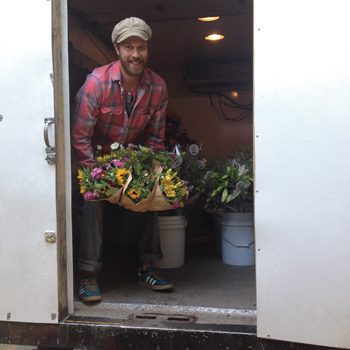
Steve Adams loads buckets of bouquets in the box truck for delivery to a supermarket distribution center.
Zinnias are our second-highestgrocery store crop. We sprayed preventatively with Triact (a neem oil derivative) to keep powdery mildew off, which helped with our fall zinnia sales. In previous years we had direct seeded and transplanted, and grown two different types of seed (Benary’s and Wildseed Farms). After last year’s experiments, we have settled on direct seeding Benary’s when possible, with our first planting being transplanted just for an earlier start. This gave us the longest, strongest stems with the largest percentage of double flowers.
Oriental lilies surprisingly were #3 on the grocery store list, but only because of Heinen’s, which wasn’t carrying locally grown lilies yet. In our area, there is a year-round lily grower, so we hadn’t had a market for lilies to grocers until we went to Cleveland. Which brings me to a good point: each market is going to be different depending on your area and competition. Please do some local research to figure out what holes there are in the market and how that fits in with your business. We had planned to cut way back on lilies and only grow what we knew our florists would buy, until this account came along and changed our plans.
Celosia cristata, ball celosia, is another top-selling seasonal bunch. We stopped growing Bombay because we didn’t have good luck getting large heads and the seed is expensive. Rather our favorite varieties are Chief, Kurume, and Higyoku, with Chief Persimmon definitely being our top performer. The grocery stores don’t really buy spike celosia bunches from us, so we grow it mainly for bouquet and some florist sales.
In our market, the customers don’t seem to like what they call the “weedy stuff”: amaranth, broom corn, spike celosia. We have learned that those items are best for mixed bouquets. We have also learned to track each product we have so that grocery and florist sales stay separate in our system, especially the seasonal bunches. Even though they are both wholesale, they sell at different prices.
Florist sales
Lisianthus is definitely #1 on the florist list at almost $8,000 in sales (which doesn’t include all the lisianthus I used for events). We grew almost 5,000 lisianthus, and it was still not enough for what the florists and I need, so this year we plan to grow a lot more. It is a flower that continues to gain popularity and now there are some fancy ones like Roseanne and Wonderous in the new Sakata line (seed available through GeoSeed). For 2015, we are ordering 20 trays of 288 cells, and have tried to start our own seed for the new varieties. I will keep you updated on our success with the seed starting and sales of the new colors. For more details on growing lisianthus, please refer to my article in the November/December 2013 issue of GFM.
Dahlias are our #2 crop with florists. We made over $7,000 wholesale on our 2,400 plants. We definitely did not have enough dahlias planted, not even for our florists. This year we are increasing to around 4,000 plants and hope to have enough for florists, my own use in weddings, and for grocery store bunches. We grow all types, from dinnerplate to miniature, and of course the Café au Lait dahlias are a big hit.
Ranunculus is a big seller for us, so we started growing it in our heated house and succession planting it to extend its bloom time. We now have ranunculus over a 3-month period (March-May), in zone 6a. The ranunculus coming out of the heated house were the best we’ve ever seen—nice, sturdy stems, and big flower heads, so they go for a higher price than those grown in the unheated house. After working our enterprise budgets this winter, we’ve discovered that even with the cost of heating the greenhouse, ranunculus is quite profitable. This year we are going to experiment with saving corms to see if we can make our input cost even lower.
Selling Oriental lilies to florists seems easier if we can have a consistent supply, so we try to have the same varieties available throughout the season. Our florists are pretty particular about their lilies, so we stick to the standard white Crystalblanca, and they like Shocking and the double-flowered Roselily Belonica as well. We tried one last year that was supposed to be red, but it ended up just being darker pink (Dutch red as Zabo Plant told me). We try to sell them by their variety names, but there are only a select few that most florists will know by name so you may have some explaining to do. Most of ours are sold with just one bud starting to crack open, but if we ever get in a lily jam, we run a sale to florists and can usually move the extra ones that are a little more open, especially if they have arrangements they are making immediately.
Dusty miller is a big seller for us, #5 on the list, and we grow both varieties: the serrated (Candicans) and the flat leaf (New Look). When florists get this shipped in it can be super short or never rehydrate, so they like the dependability of the dusty we can provide. Ours is grown in covered space to ensure clean foliage, but this year we are putting some in the field. We recently have been battling Phytophthora in the soil of one of our greenhouses, and the dusty has been one of the things most affected, forcing us to have more space between plants and making it less profitable in the tunnels than originally calculated.
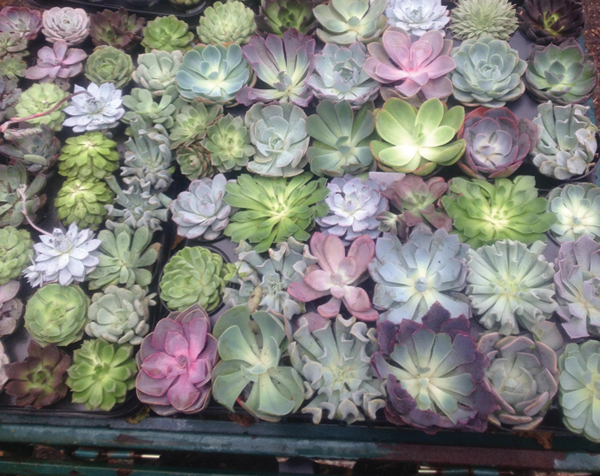 Succulents are purchased in 2” pots and resold to florists.
Succulents are purchased in 2” pots and resold to florists.
We grow a lot of succulents and these are next on our florist list for sales, especially with their popularity with the plant nerds of my generation. Since we sell so many and our wedding business uses a lot, it is hard for us to keep them in stock through our own propagation, so we do order in occasionally. We get ours from The Cactus Shop in California, and will sell them direct to florists in the 2” pots they come in. This year we are going to try North Carolina Farms because shipping will cost less, but those will need to be potted up, so we will have to see which one is most cost-effective. We are also going to try buying unrooted cuttings, and are doing a lot more experiments with our own propagation after some research this winter. Our goal is to be able to produce enough to keep up with our own sales without having to order any in, decreasing input cost.
Stock (Matthiola incana) is another of our top florist crops and all florists seem to use it, even the more traditional ones. I know we love it, and grow more each year. This is a cooler weather crop, so for us is grown in covered space, starts blooming in March, and is done by mid June. For more information about growing stock as well as our favorite varieties, check out my article in the October 2014 issue of GFM.
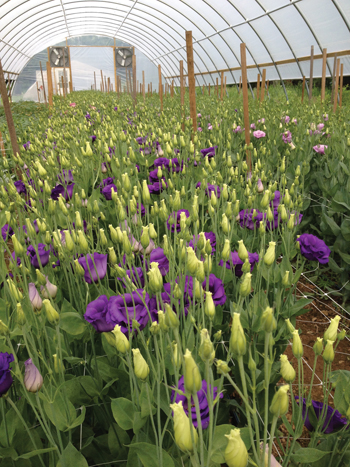
Below: Last year’s planting of 5,000 lisianthus plugs was not enough to meet demand from florists and for weddings, so Sunny Meadows will grow even more this year.
Celosia is at #8 on the florist list, mainly the ball type (see above for varieties). The florists buy some spike celosia, but not a ton. They mainly like the Sunday Orange and Sylphid. We like Celway Terracotta for a vintage blush look, but our florists think it looks dirty, so we will be switching to Sunday Salmon, which they seemed to like better.
Snapdragons are a cooler weather crop like stock, except we can get fall production out of them as well. This means we sell them from April-June and then again October-November. These are the tall snaps that are mainly one and done coming out of the greenhouse. In the summer, field snaps just aren’t the same, so they have been cut from the repertoire.
Surprisingly, sunflowers made the top 10 in the florist crops. We had issues with downy mildew a couple years ago and lost 2 acres of sunflowers, which knocked out our sunflowers for grocery stores. Once we didn’t have them, we decided we preferred growing them only for florists and our own bouquet usage, so this year we planted for those purposes. We actually could have sold more to florists if we had them, so will be increasing them again this year, but not up to the quantities we used to grow. Now we don’t plant ‘ProCut’ until the heat of summer, as they are most susceptible to downy mildew. We hear some resistant varieties are in the works. We are still in search of the best replacement for them though, and we don’t need the enormous head size for grocers anymore, so this year are trying ‘Vincent’ sunflowers.
Next on the list of florist crops, in order, we have: pumpkin on a stick, dianthus, tulips, anemones, geraniums, salvia, peonies, hydrangeas, amaranth, and flowering kale. Our florists don’t buy a lot of the unique, funky stuff. Most of those crops we grow get absorbed into our own weddings and events anyway. And to put it into perspective, our business is about 33% grocery sales and 23% florist sales. The other half of our farm sales are 26% weddings, 12% farmer’s markets, and then 2% each of the following categories: Gretel’s Handcrafted line, teaching/writing, and tuber sales. For 2015, we project the breakdown will be about the same. Here’s to another great year!
Gretel and Steve Adams are the owners of Sunny Meadows Flower Farm in Columbus, Ohio. Visit them on the web at www.oursunnymeadows.com.

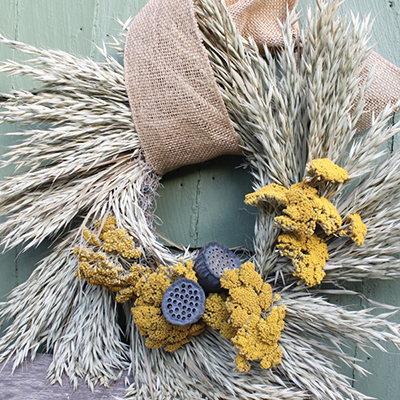


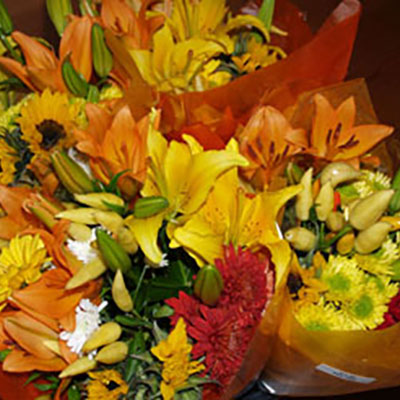
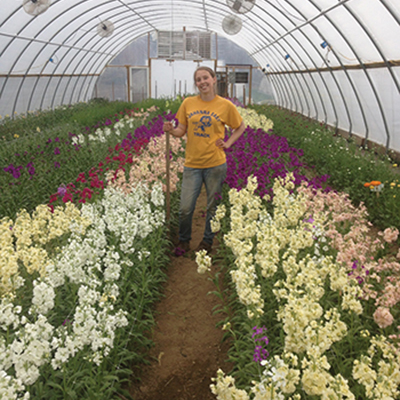
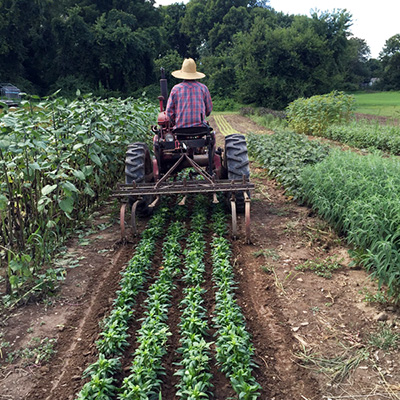
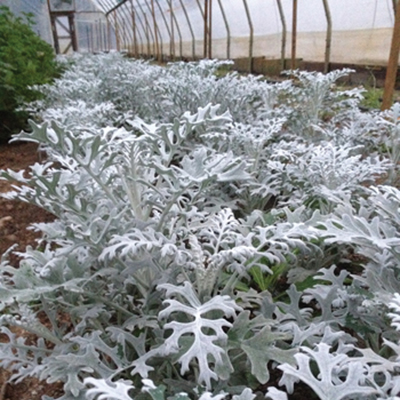

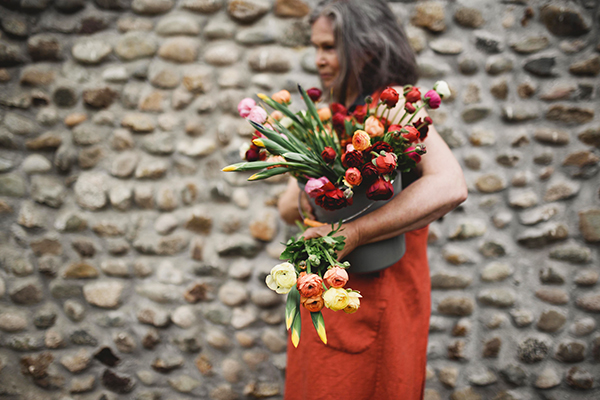 Lorna Jackson started flower farming intensely relatively later in life at Ninebark Farm on a century-old hayfield in Metchosin at the southern tip of Vancouver Island in British Columbia, Canada. Now 64, she plans to continue into her 70s. To keep going, she makes adaptations to ease the toll on her body.
Lorna Jackson started flower farming intensely relatively later in life at Ninebark Farm on a century-old hayfield in Metchosin at the southern tip of Vancouver Island in British Columbia, Canada. Now 64, she plans to continue into her 70s. To keep going, she makes adaptations to ease the toll on her body.
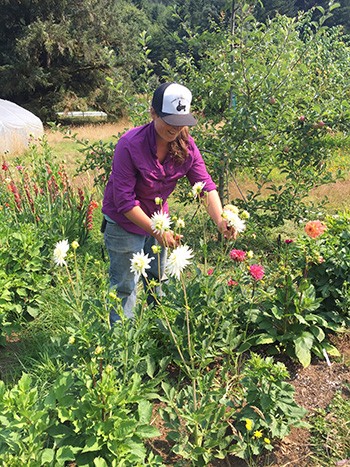
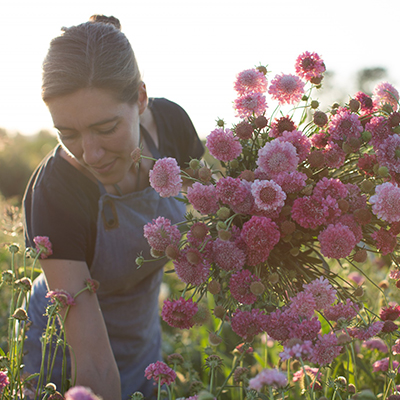
 Marketing is the other half of the battle
Marketing is the other half of the battle